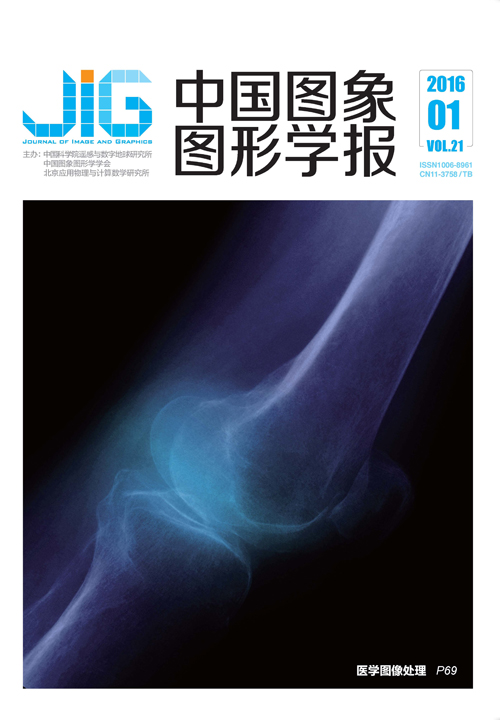
多主体框架下结合最大期望值和遗传算法的SAR图像分割
摘 要
目的 SAR图像中固有的相干斑噪声增加了图像分割的困难.为此,提出一种分布式SAR图像分割算法.方法 首先假设图像中同质区域内像素满足同一独立的Gamma分布,依此建立SAR图像模型;为了刻画SAR图像中像素的类属性,建立标号场的MRF(Markov Random Field)模型;在Bayesian理论框架下建立图像分割模型;在多主体系统(MAS)框架下,结合MRF模型和遗传算法(GA)模拟分割模型.MAS结构由分割主体和协调主体组成,其中分割主体利用最大期望值( EM)算法估计MRF模型参数,从而实现全局分割;协调主体利用GA实现全局最优.结果 为了验证提出方法的有效性,分别对模拟和RADARSAT-I/II SAR图像进行实验,并与EM和RJMCMC算法比较.本文算法的用户精度、产品精度、总精度及kappa系数均高于EM算法.定性和定量分析结果验证了本文算法的鲁棒性和有效性.结论 实验结果表明提出的分布式MAS框架下SAR图像分割方法,能够提高分割精度.该方法适用于中高分辨率单极化的SAR图像,且具有很好的抗噪性.
关键词
Combining the expection maximization and genetic algorithms for SAR image segmentation within a MAS framework
Zhang Jinjing, Li Yu, Zhao Quanhua(Department of Geomatics, Liaoning Technical University, Fuxin 123000, China) Abstract
Objective The speckle appearing on SAR images is a natural phenomenon generated by the coherent processing of radar back scattering. The presence of speckle not only reduces the interpreter's ability to resolve fine details but also hinders the automatic segmentation of such images. In remote sensing image analysis, the spatial structure hidden in an image may contain even more information than the pixel itself, particularly for SAR images, where the large variability owing to the speckle noise makes the single pixel value unreliable. In particular, Markov random field (MRF) presents many interesting properties to model the relationship among neighbor pixels, which not only allows the creation of segmentation techniques that are able to improve segmented results in a statistically optimal manner but also provide an efficient regularization method, which is necessary because image segmentation is an inverse problem that is generally ill-posed from a mathematical point of view. However, MRF-based spatial dependency models lead to an extremely large amount of computations for the estimation of model parameters with a standard expectation-maximization (EM) algorithm. Moreover, the EM-based model parameter estimation is performed over the whole image and does not reflect local image properties. To improve MRF-EM image segmentation, this paper proposes the identification of the global MRF segmentation model by distributing a set of EM procedures within a multi-agent framework. The image is segmented into situated agents, which estimate the parameters of an MRF model. Local features are changed by a cooperation agent with genetic algorithms (GA).Method To address a statistical approach to SAR intensity image, each pixel in the image is assigned a label to indicate the homogeneous region to which it belongs depending on the statistical properties of the pixel and its neighbors. The individual labels form a so-called label field, in which labels are modeled with a prior Potts model where labels of neighboring pixels will tend to be similar. In each homogeneous region, the pixels are modeled with Gamma distribution with parameters that are dependent on the type of region. By Bayesian theory, the segmentation model can be built by producing the image model and label model. To simulate the segmentation model, an approach combining EM algorithm and GA within a multi-agent system (MAS) framework is proposed. The MAS is composed of a series of segmentation agents and a cooperation agent. Each segmentation agent initializes a global segmentation by EM algorithm, and the cooperation agent employs GA to implement global optimal segmentation. The parameters of the model are estimated by E-and M-steps, and global segmentation is also completed simultaneously. GA attempts to obtain an optimal segmentation by genetically breeding a population of individuals obtained by the segmentation agents. Each individual is encoded by the label field as a chromosome, and each chromosome defines a measure of fitness built by the segmentation model. Fitness can be applied to determine the ability of the chromosome to survive and to produce an off-spring. To obtain optimal segmentation, the selection operator directly inherits individuals from parents by roulette, and the crossover operator exchanges some pixels from pairs of parents to produce new off-springs.Thereafter, the mutation operator changes certain site labels, which are randomly selected and replaced with another category depending on its neighborhoods. Result Experiments are conducted with simulated and real SAR intensity images by the proposed method and EM algorithm, respectively. Results show that the proposed methodhas better image segmentation performance than the EM method. The problems of edge blur and segmentation mistake in homogeneous regions are solved by combining the distributed EM procedures and genetic operators. The selection operator diversifies the segmentation results, and the crossover process performs global exchanges.Furthermore, the mutation process ensures that the agents can escape from a local point. Therefore, the global optimal solution can be obtained. To quantitatively analyze this method, the overall accuracy and Kappa coefficient of the producers and users are calculated from the confusion matrix and are compared with those of the EM algorithm. Result shows that the presented approach is more accurate than the EM algorithm. All experiments demonstrate the robustness and veracity of the proposed approach.Conclusion This paper presents a distributed segmentation approach that combines the EM algorithm and GA within the MAS framework. The experiment results indicate that the proposed approach is effective and promising. Although this method produces excellent results, efficiency still needs improvement.Furthermore, MAS has many functions that can be used for segmentation. In the future, our research will focus on the definition of each agent and the interaction among agents (e.g., communication).
Keywords
multi-agent system Markov random field model expectation maximization genetic algorithms SAR image segmentation
|



 中国图象图形学报 │ 京ICP备05080539号-4 │ 本系统由
中国图象图形学报 │ 京ICP备05080539号-4 │ 本系统由